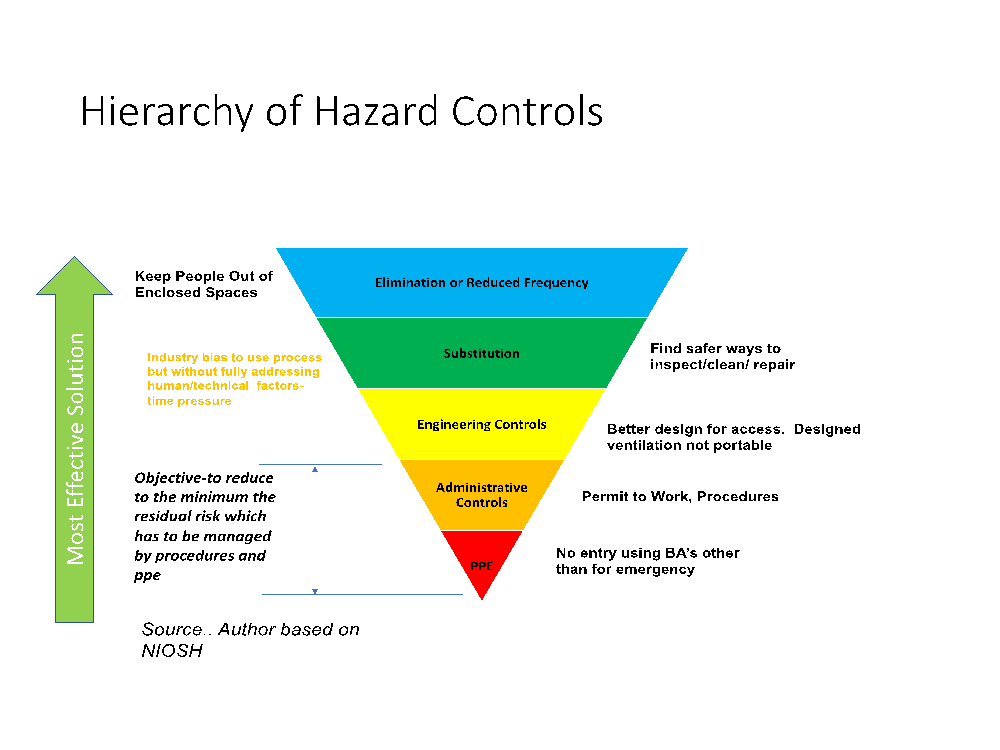在防止封闭空间内死亡的进步
To prevent the progress of death within enclosed Spaces
发布者:knowmi 发布时间: 2021-12-25 12:12:26 点击量: 3182 来源:knowmi
IMarEST 是 Human Element Industry Group ( HEIG )的成员,该组织是一个有影响力的非政府组织,旨在提高安全性。该小组去年一直在研究封闭空间死亡问题,并在 2022 年开始推出结果。该项目涉及来自 16 个 HEIG 参与者的大约 50-100 名成员。
封闭空间事故是船上最大的职业杀手,而且几乎没有改善的迹象。每年约有 10-20 名海员死于封闭空间。调查往往会责怪受害者不遵守程序而不进行更深入的调查。Intermanager 最近对 5000 名海员进行了一项调查。该调查得出了一些有趣的观点。
· 程序在海员看来往往难以理解、令人困惑,并且没有考虑到船上可用的资源、设备和时间。
· 调查指出受害者的失误,特别是他们未能遵守程序。
· 商业/时间压力是一个重要因素,被描述为“接近滥用”。
· 设计和设备通过制造危险增加了问题。
· 培训被视为仅限于油轮行业。
作为 IMarEST 的成员,我们需要意识到封闭空间的死亡虽然主要发生在货物区域,但也可能发生在其他地方,包括燃料舱、其他消耗性舱甚至机器内部。许多成员可能不得不进入封闭空间,包括海上空间,参与测量、造船和维修。
封闭空间项目有多个工作流程,来自 HEWG、海军工程 SIG 和船舶维修、维护和安全 SIG 的大约两打 IMarEST 成员已参与其中。两个最大的工作组由 IMarEST 领导。
考虑到海上人员的反馈,该项目使用了危害控制的层次结构(见下文),这是一种广泛使用的模型,前提是如果您消除了危害,就没有风险,也不需要管理它!

这与技术解决方案工作组特别相关,该工作组拥有强大的 IMarEST 代表,并研究您如何设计人们进入危险空间的需求。这包括考虑减少进入封闭空间的要求,并允许在不进入空间的情况下进行维护和检查。无人机、远程摄像机、数字对和远程清洁机器人也被考虑在内。如果仍然需要进入,则需要查看访问和通风以及监控系统。一个“工作组”提出了一些关于如何改变封闭空间分类和管理方式的主要想法。
时间压力工作组正在研究时间压力对封闭空间进入的影响。时间压力是行业中更广泛的问题,甚至可以追溯到泰坦尼克号和自由企业先驱等事件。虽然 ISM 是为了处理《先驱》的教训而创建的,但它似乎并没有解决时间压力的问题。近 30 年来,承租人、船东和港口仍然对船舶施加过大的压力,这可能导致在检验之前对油舱进行通风的时间受到限制。正如我们所知,时间压力也会影响导航。运输是全球供应链不可或缺的一部分,随着客户使用准时交货降低库存成本,准时到达和准时启航的压力也在增加。
当一切都说完了,总会有进入封闭空间的需要,其他工作组正在研究它的其他方面。
一组正在研究法规和程序以及如何改进它们。封闭空间入口复杂、资源密集,需要大量“活动部件”才能组合在一起工作。另一个涉及海上事故调查员论坛的小组正在制定有关调查封闭空间死亡和时间压力的指南。这项工作将用于影响船旗国和船东调查的进行方式。培训也正在接受审查 在接下来的几个月中,将从这项工作中学到的所有知识都将推广,以期提高意识、改进培训并推动行业和监管变革。
The IMarEST is a member of the Human Element Industry Group (HEIG), an influential group of NGO’s aiming to improve safety. The group has spent the last year researching the problem of enclosed space deaths and in 2022, we will start rolling out the results. The project has involved about 50-100 members from the 16 HEIG participants.
Enclosed space accidents are the biggest occupational killer aboard ship and there is little sign of improvement. Some 10-20 seafarers die a year in enclosed spaces. Investigations tend to blame the victim for not following procedures without looking any deeper. Intermanager recently ran a survey of 5000 seafarers. Some interesting points came from that survey.
· Procedures often seem to seafarers, difficult to understand, confusing, and do not take account of the resources, equipment and time available aboard the vessel.
· Investigations point to failures in the victims and in particular their failure to follow procedures.
· Commercial/time pressure is a significant factor and was described as ‘verging on abuse’.
· Design and equipment added to the problems by creating hazards.
· Training was seen as being limited to tanker trades.
As IMarEST members, we need to be aware that enclosed space deaths, while mostly occurring in cargo areas, can also occur elsewhere including in bunker tanks, other consumable tanks and even inside machinery. Many members may have to go into enclosed spaces including those at sea, involved in surveying and shipbuilding and repair.
The enclosed space project has a number of workstreams and about two dozen IMarEST members from the HEWG, Naval Engineering SIG and Ship Repair, Maintenance & Safety SIG have been involved. Two of the biggest workgroups are led by IMarEST.
Taking onboard the feedback from those at sea, the project used the hierarchy of hazard control (see below) which is a widely used model based on the premise that if you remove a hazard, there is no risk and no need to manage it!

This was particularly relevant to the technical solutions workgroup, which had a strong IMarEST representation, and looked at how you engineer out the need for people to go into dangerous spaces. This included looking at reducing the requirements to enter enclosed spaces and allow maintenance and inspection to be carried out without entering the space. Drones, remote cameras, digital pairs and remote cleaning robots have also been considered. Where entry is still required then there is a need to look at access and ventilation as well as monitoring systems. One ‘task force’ has come up with some major ideas on how to change the way enclosed spaces are classified and managed.
The time pressure workgroup is looking at the effect of time pressure on enclosed space entry. Time pressure is a wider problem in the industry even going back to such incidents as the Titanic and the Herald of Free Enterprise. While ISM was created to deal with the lessons of the ‘Herald’ it does not seem to have dealt with the problem of time pressure. Nearly thirty years on ships are still being put under excessive pressure by charterers, owners and ports which can result in time being limited for ventilating tanks prior to surveys. Time pressure also affects navigation, as we know. Shipping is an integral part of the global supply chain and as customers reduce their stockholding costs using Just in Time delivery the pressure to be arrive on time and indeed sail on time increases.
When all is said and done there will always be a need to enter enclosed spaces and other work groups are looking at other aspects of it.
One group is looking at regulations and procedures and how they can be improved. Enclosed space entry is complex, resource intensive and require a lot of ‘moving parts’ to fit together to work. Another group, involving the Marine Accident Investigators Forum are working on guidance for investigating enclosed space deaths and time pressure. This work will be used to influence the way that flag state and owners’ investigations are carried out. Training is also being reviewed Over the next few months all of the learning from this work will be rolled out with a view to increasing awareness, improving training, and driving industry and regulatory change.